Why Japanese People Live So Long- A comic essay
/You can get more comics like this as soon as they post by subscribing to my newsletter, A New Creative Life, by CLICKING RIGHT HERE.
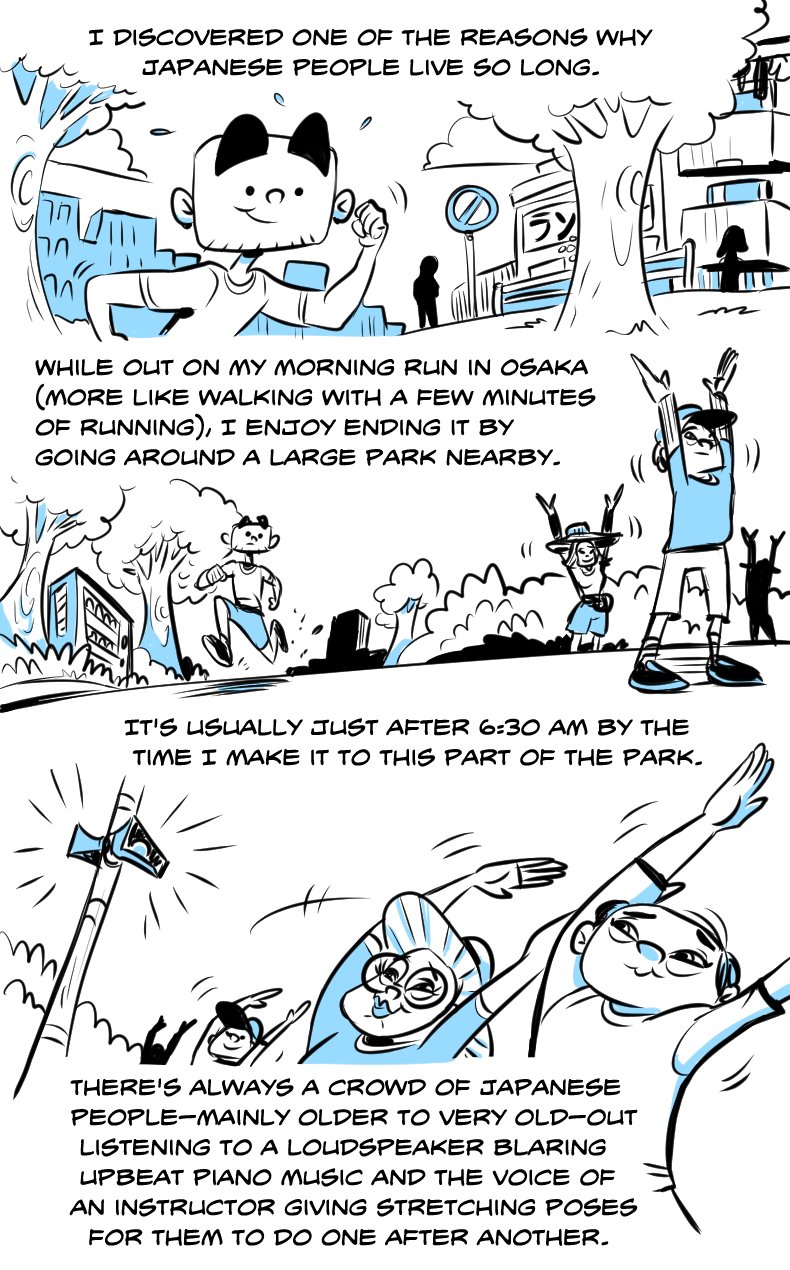
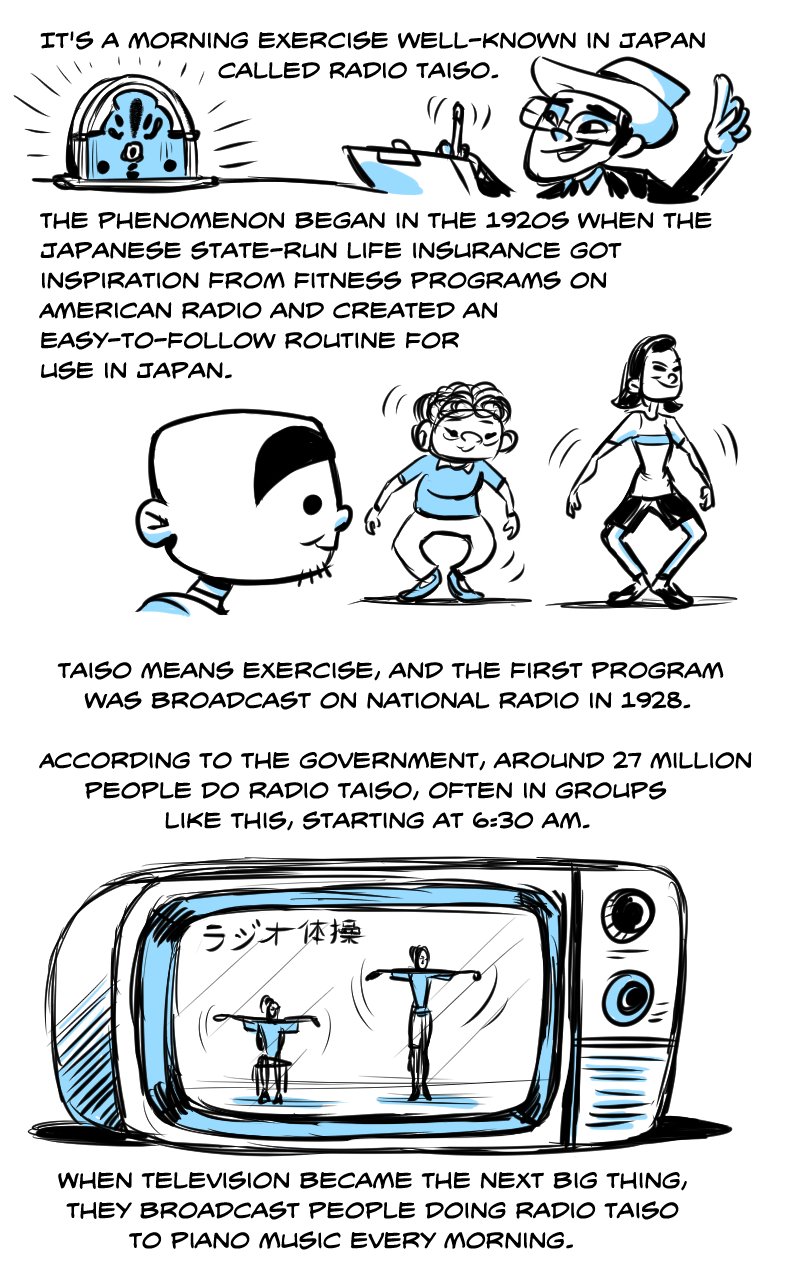
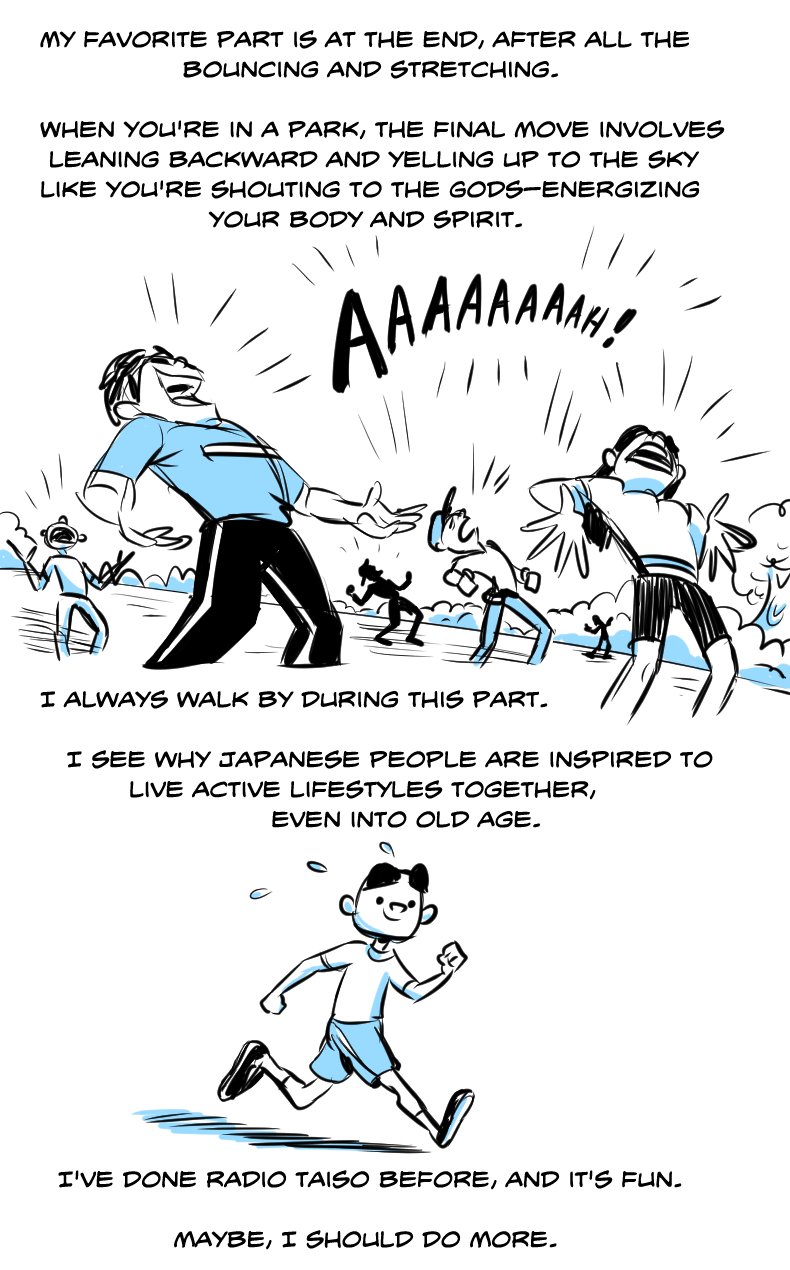
You can get more comics like this as soon as they post by subscribing to my newsletter, A New Creative Life, by CLICKING RIGHT HERE.
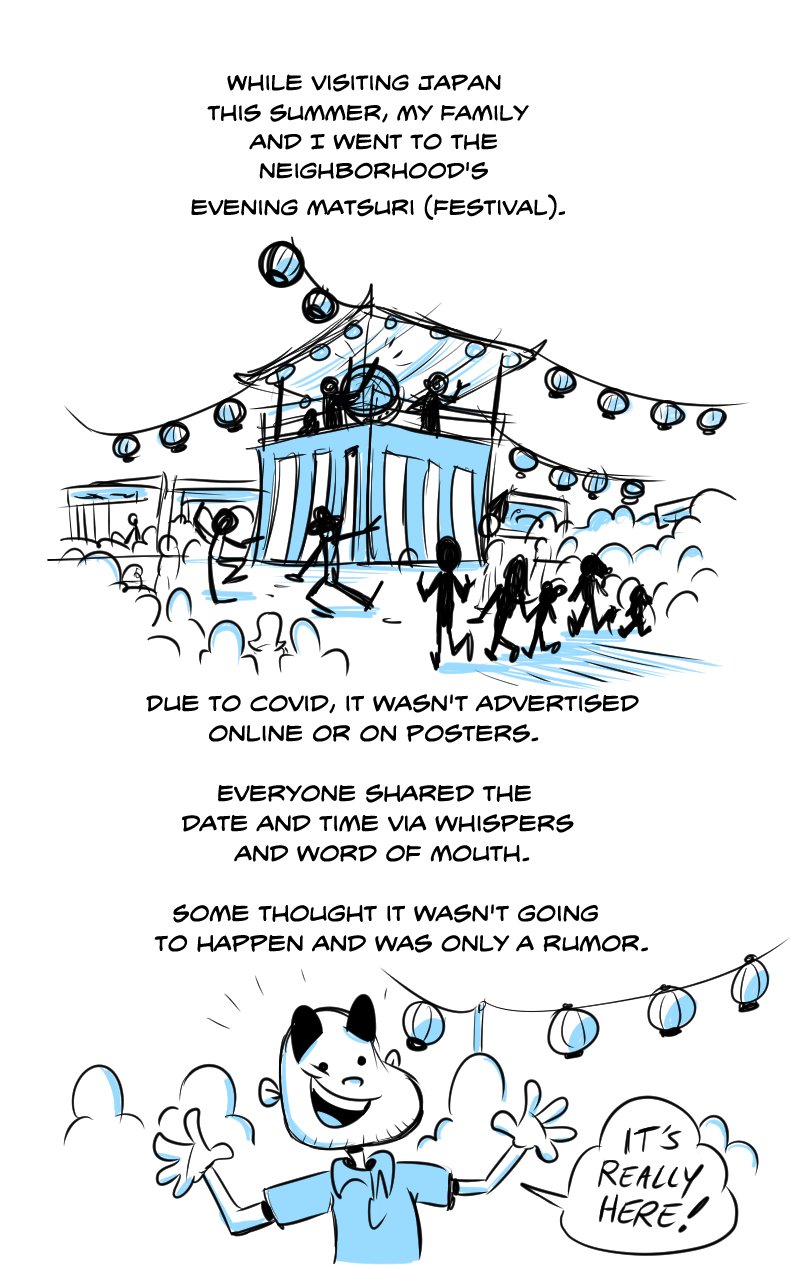
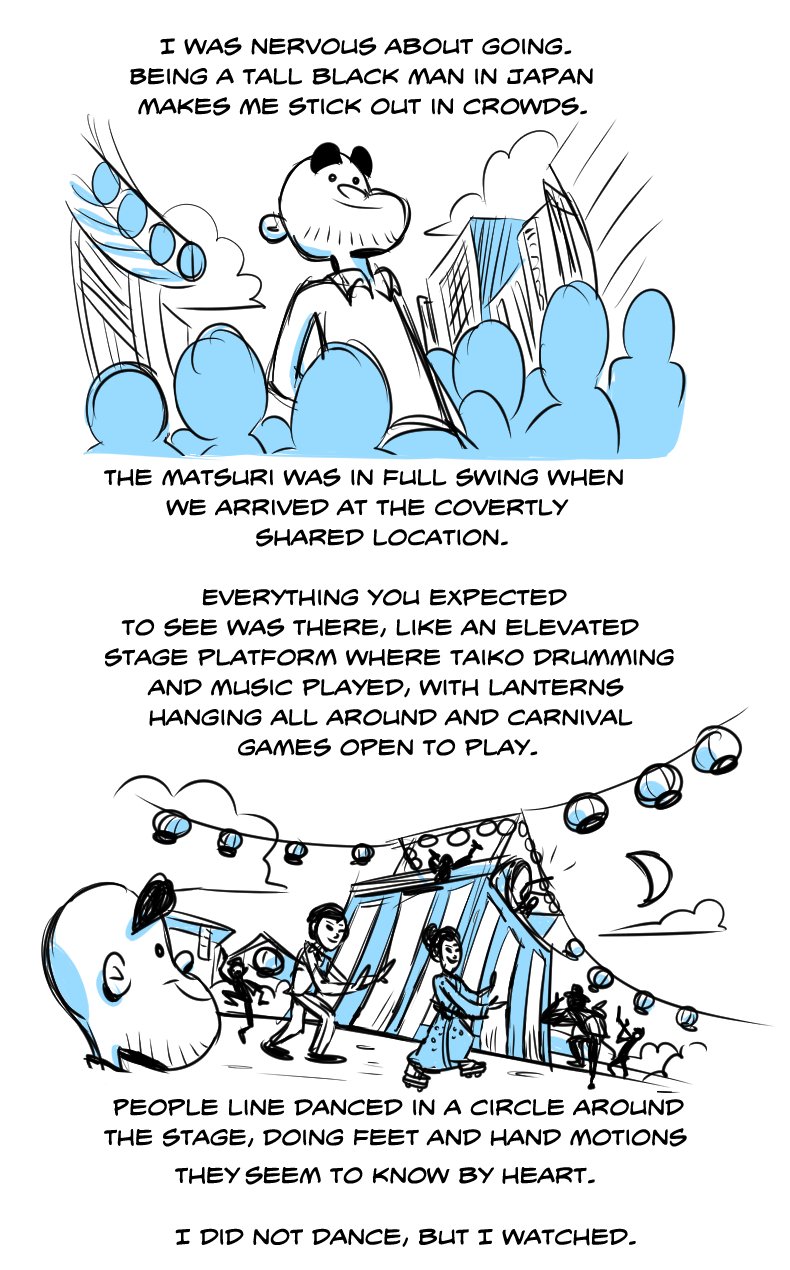

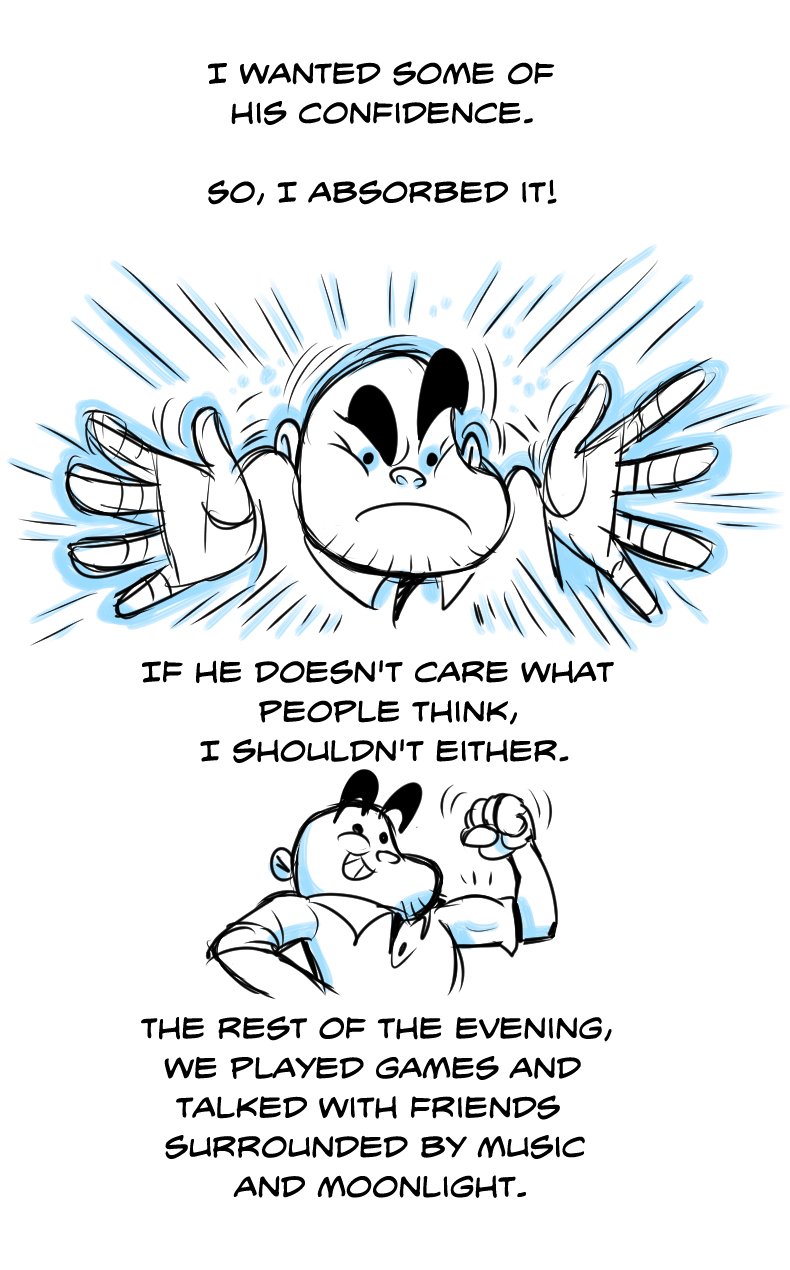

Get advice about living creatively and read more of my comic essays by joining the A New Creative Life newsletter.

Would you freak out if you saw a raccoon calmly sauntering its way through the ticket gate to the subway? Almost like it does this every day.

Just an average day for a busy tanuki.
On September 2nd, a little furry commuter was seen at Shinjuku Station in Tokyo, Japan, walking in amongst thousands of other people on a busy Friday evening.
In the photo above and video below, you can see it even had its own personal usher on hand, a station employee clearing a path for it and ensuring passersby gave it personal space. Even though it was treated like a celebrity — it was only a wild tanuki.
JR新宿駅構内にタヌキがいた。 pic.twitter.com/2veMxdtvz1
— CORE Kaopy (@core_kaopy) September 2, 2022
A reader of my Little Fried Chicken and Sushi strip shared this story with me in the comments on the GoComics site, and it got my imagination racing. A tanuki is thought of as a magical creature in Japan that can shapeshift and play tricks on people. Was there a spell involved in this encounter?
I love having Tanuki as a character in my strip, and this event brings the idea of an animal doing human things to life in a new way. Some might have wondered if this raccoon forgot to turn itself into a salaryman to blend in. Maybe it uses the train regularly to get around Tokyo?
The Shinjuku train station it was spotted in has a mascot of a Tanuki with a white swirl on its belly. The mascot’s name is TanuTanu. Was this the real thing?

An advertisement for TanuTanu the subway mascot.
No one was sure about where the Tanuki came from, but it was spotted at the station around 9:30 p.m. The staff guided it from the platform, and the animal went up the stairs and towards the New South Exit, where the video was taken. Then, it walked through the ticket gates and disappeared into the night.
We’ll never know what the Tanuki was up to, but it sure seemed comfortable in its surroundings. Not scurrying away, frightened of people, makes you think it does this often without much fanfare.
The city must be a tough place for a raccoon. I’m glad the station attendants helped him get where he needed to go.
It’s similar to the time Tanuki started working an office job. It didn’t last too long, though.
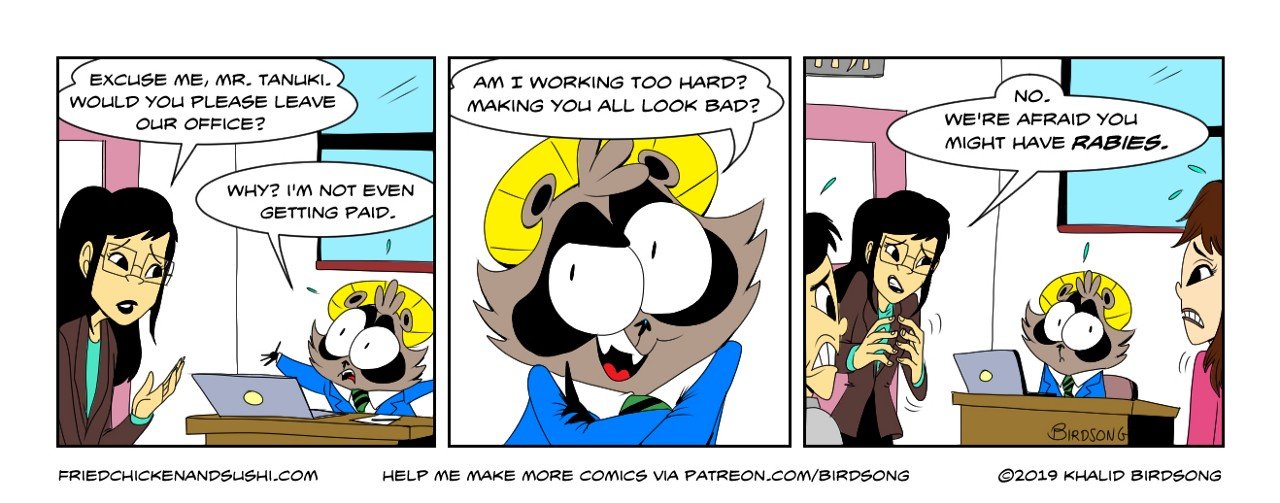
P.S. If this was indeed “the” TanuTanu mascot, spirit of, or a real magical tanuki on his way home from a long day of work pretending to be human, it stood out. Still, it was ultimately accepted by the people all around.
The video and news reports didn’t talk about people running away from it in fear or getting scared because a wild animal was walking next to them.
As a human being, a black male, who gets stared at, surprises others by being a tall foreigner on the train and sticks out just about everywhere when I’m visiting Japan. I’m not sure how to feel about this. A wild tanuki in the subway station is unique enough to make the news, but it doesn’t shock or get people’s attention the way a person who looks different can.
Sometimes, I wish I could shapeshift into a tanuki, ride the train with help from attendants, and everyone thinks it’s so cute.
Am I jealous of TanuTanu, the raccoon? Not really. Maybe a little envious, though.
CLICK HERE to join my email newsletter A New Creative Life and get these updates directly in your email inbox.

A couple admiring all the gachapon choices. Photo- Rittis/Shutterstock.com
Gachapon or gacha gacha capsule toy machines have exploded in Japan.
They’ve been popular for years, but I kept seeing them everywhere in Osaka during my latest trip—entire store sections of them in malls and even at revolving sushi restaurants.
I was only away for three years, and now almost any kind of toy is in a gachapon.
They’re like gumball machines where you put your coins in and turn the knob, it makes a gacha gacha sound, and a plastic ball falls out with a toy inside. You pop it open and see which character or object you’re lucky enough to collect this time.
Each machine has a different toy theme based on anime characters or just about anything imaginable. Yup, there are plenty of gacha toy collectors hoping to find that missing character from their collection. It’s not just for kids. Adults love discovering their favorite gachapon wherever they go.
Most gachapon toys cost around three hundred yen each or roughly three dollars, which might sound expensive, but it doesn’t feel like it because you’re using coins.
There’s a one hundred yen coin, and dropping three of them in a gachapon feels easy and fun. I couldn’t resist taking photos of some of the more interesting toys available for your gacha gacha purchase.
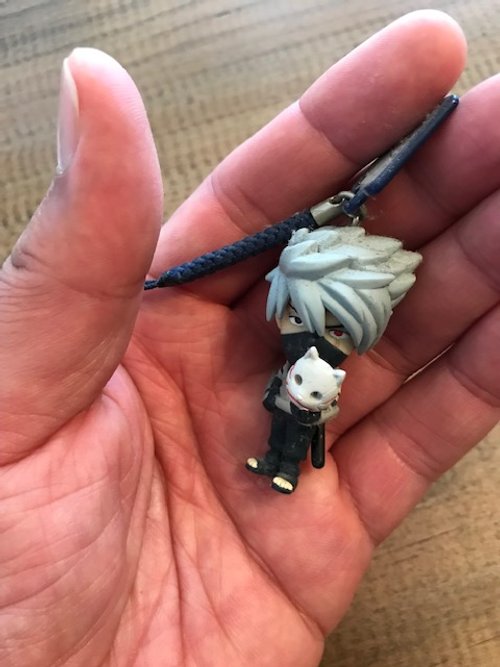
Here’s a Naruto gachapon toy in my hand for size reference.

Who wouldn’t want birds hugging bread?
Cute animals are everywhere doing strange things. Maybe some of these are associated with manga or anime, or they’re mainly there to make you smile and wonder about their meaning.

Cute bears wrapped in food? Should you hug them or eat them?

Panda bread looks delicious!

Cute kitty cat pancakes. They don’t look very happy to me.

Aaaaah! Scary cats!!
Sometimes, the animals are busy doing one of their hobbies. Or waiting for you to squeeze them.

This one looks like a cat’s dream.

Nothing’s more relaxing than squeezing the life out of a cute squishy bird.
If you’re a foodie, I guess these gachapon toys might be something you could collect.

Oooh! The sashimi looks so fresh!!

Stackable burgers are so hot right now.
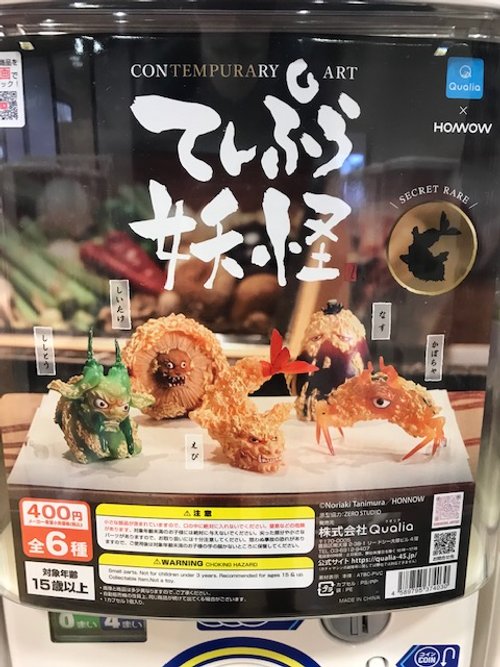
Wait. Is this even food?
I didn’t know furniture was an option for gachapon toys. If you’re into miniature models, these are for you.

Airplane seats that recline. Buckle your seatbelts.

I love the sophistication of this Karimoku collection. So rich!
I purposely avoided the standard cartoon character toys based on anime and manga you see everywhere. It was fun looking for ones that were creative and different.
I couldn’t resist these, though.

Mini Squid Game murderers for your keys.

You can get the whole bloody family!
If you visit Japan someday, make sure to get a few gachapon toys. They make great souvenirs and are fun to shop for while you’re sightseeing.
What creative capsule toys have you seen or bought?
A New Creative Life is a reader-supported publication. To receive new posts and support my work, consider becoming a free or paid subscriber.
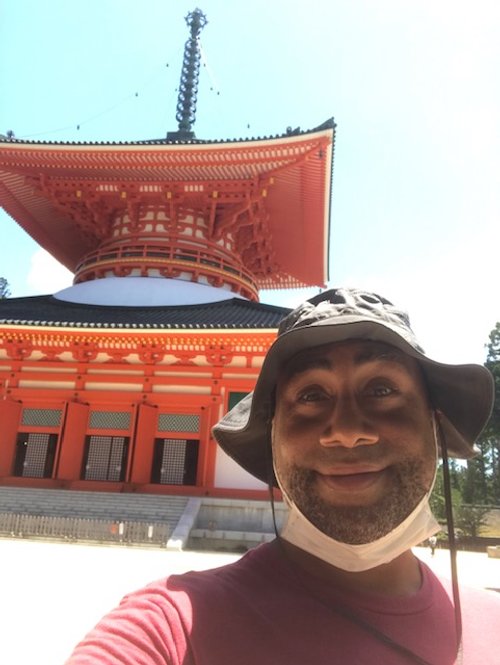
All photos were taken by or illustrated by the author.
I like knowing I’m doing the right thing. Who doesn’t?
Making sure to meditate every morning is something I think I’m doing right, but I’m probably wrong. Accepting your biases and thinking your point of view may not be accurate is something I’m working on improving.
I can say, sitting in silence for 10–20 minutes first thing in the morning helps me face my emotions head-on. When it’s time to write or draw, it’s easier for me to plug into my creativity and get going.
There must be something to it.
I just recently returned from a phenomenal trip to Koyasan, a town on top of a mountain full of ancient Buddhist temples in the Kansai region of Japan. I’ve wanted to go for many years. Visiting my in-laws in Osaka allowed me to finally get close enough to make the overnight expedition happen.
Even if you’re not a practicing Buddhist, you can pray in the temples, as long as you throw a few coins in the donation bin before clapping your hands twice and bowing.
Getting up to the temples is no joke.
You can only take a cable car straight up the mountain. Beautiful views, but you definitely feel far removed from the regular world below.
I believe Kobo Daishi, the monk who established the town over a thousand years ago, meant it as a place for zen training and meditation. You can tell by the calmness all around the area.
Many of the original temples were burned down during wars or due to lightning strikes but rebuilt multiple times over the years and are gorgeous.

The temple we meditated in during our visit. The doors were open, but no pictures were allowed inside.
This is the temple next to the ryokan (Japanese traditional style hotel) we stayed in during our visit. The doors are closed now, but they were open for us to have an enjoyable meditation class inside in the morning.
You’re not allowed to take photos of the interior but believe me, the decorations were ornate and beautiful. We had two monks sharing how to pray and meditate.
I remember them mentioning sitting with your legs crossed with the left one under the right. Your hands are in your lap, palms up, with your left hand under your right as well. Somehow, you should close your eyes almost all the way shut, not fully closed, and look down at your nose.
They said this helps you focus more, but I kept closing my eyes after about twenty seconds.

We couldn’t be in the full crossed legs position because the monks had us sit on small benches inside the temple. Placing our hands together and breathing deeply for several minutes is something we could do while sitting.
Looking at my nose and holding my left hand under my right, palms up, helped me focus on being in the present moment. Now, when I’m at home practising, on the floor with my legs folded and my hands, I notice how much smoother I ease into deep meditation.
My mind wanders less at first.
Getting your body in the proper position and posture truly makes a difference. I knew sitting on the floor with my back straight helped before, but now I’m even more convinced stacking your hands and touching your thumbs together helps to center your mind.
The monks showed us that rocking side to side helps to loosen your body if sitting in the position is uncomfortable at first. I understood that even monks have days when sitting correctly may be difficult.
In the beginning, you can always find a way to make something work better for yourself.
We also practised writing calligraphy with a brush pen when we returned to our room. I couldn’t write Japanese, but it didn’t matter. I mainly had to trace.
The kanji characters were underneath; all you had to do was brush over them. The writing is about living a peaceful life, and the monks recited this during our meditation practice time. Writing with a brush pen was meditative and took more time than I thought, but I stuck with it.
I felt there was a lesson there.

The results of my calligraphy writing practice.
As a cartoonist, one of my favorite details about Koyasan, and just about everywhere in Japan, is how they have cute mascots.
This little monk character, Koyakun, was everywhere we went, giving advice and showing us around.

Koyakun was everywhere with helpful signs to guide you.
Koyasan monks practice Shingon Buddhism. Therefore, how they taught meditation goes along with how that particular sect practices.
Even with their advice, I still believe you can meditate any way you choose. It’s easier if you think about it openly and not full of strict rules.

You should start a meditation practice if you haven’t already. We hear some of the benefits of meditation, like more self-awareness and clear thinking, but is this true for everybody? The statistics would say so. In fact, a lot of folks are into “facing themselves” daily.
-It is believed that between 200 and 500 million people worldwide meditate.
-Data from the National Health Interview Survey in 2017 showed that 16.3% of women meditate, compared to 12% of men.
-The Headspace meditation app has been downloaded sixty-five million times. [10]
If you’d like to try meditation, I suggest relaxing your expectations with how you think it should look. Sometimes you can talk yourself out of something great because you feel it must be done a certain way. Like it would be best if you resembled a bald monk sitting cross leg with perfect posture for hours.
I try my best to sit their way, with my left leg under and right leg on top and hands in my lap palms up, but sometimes I sit in a chair.
The most challenging idea for me to accept is that it’s all about mindfulness and not how you sit. Being present when and where you are and noticing your body and thoughts.
That’s it, pretty simple.
Whether you’re doing this for ten minutes — which I think is the minimum amount of time to notice a difference — or an hour, you can focus on yourself anywhere. There are times when I’m stressed that stopping what I’m doing and taking three deep breaths helps to calm me down.
All the distractions in our modern world can block our thinking. You must deal with your emotions, swimming around, desiring your attention, and making space to work things out in your subconscious.
Meditating is genuinely part of a creative life. Add as much of it as possible to your day, and watch as you calm down and think clearly more often.
Of course, I could be wrong, but it’s the most specific change I made to my life over twenty years ago, and I continually see positive results. When life gets crazy, I meditate more.
Here are more stats if you need a push to get started.
-Research conducted in 2016 sought to discover the health benefits of meditation and understand the practice’s growth. Below is the list of reasons given for starting to meditate:
General wellness (76.2%)
Improving energy (60%)
Aiding memory or concentration (50%)
Anxiety (29.2%)
Stress (21.6%)
Depression (17.8%)
In the case of all the above conditions, 60% of the people questioned in the study reported that meditation helped them significantly.
-People who meditate can reduce their chance of being hospitalized for coronary heart disease by 87%. [10]
The groundbreaking research was initially conducted in 1989 and followed up fifteen years later to see if the mantra meditation was still working its magic.
It was found that the group who used the technique had a lower CV mortality rate than those who didn’t participate in the practice.
The 1989 project focused on 73 residents, and further research has backed up the finding; however, it is still felt further research is needed to understand the full effects.
They, just like me, could be wrong.
-But wait! Did you know that 25% of people who meditate report having an unpleasant psychological experience? [23]
I guess meditation isn’t for everyone. A study of 1,232 participants found that a quarter experienced adverse effects such as anxiety, fear, and distorted emotions.
Sure, the study might have been confirmed, but we have no idea what was going on in the lives of the people in this study at the time. You know I’m open to hearing other arguments, but I believe most people will feel positive benefits from regular meditation if they try it for a month or more, and this should be enough time to turn it into a habit.
You don’t need to travel to Japan and ascend a mountain to practice meditation—hopefully, I helped you see that. When you practice, I bet you’ll appreciate my shared benefits.
I love how you can become more aware of what’s right for you when you meditate regularly. Your “still small voice” gets louder, and you make better decisions. Decisions that are based on what you truly desire.
Knowing how to pause before, say, picking your phone right up when notification dings and waiting to finish writing that page is what I love. You can have more control over yourself when you’re aware of what you’re doing.
Thanks for joining my Koyosan adventure and learning more about meditation.
How do you meditate?

Image courtesy of Wikimedia Commons.
Japan’s population needs to grow faster, or it will cease to exist.
At least, this is what billionaire Elon Musk believes. Japanese people need to start making more babies for the country to survive. I agree, but I think it’s more complicated.
Living in Japan for several years as an English teacher taught me a lot about the culture. Being married to a Japanese woman and then visiting from America regularly over the past twenty years gives me an inside and an out-of-the-box view of the issues.
Even with this knowledge, I was surprised by Elon’s tweet.

Screenshot of Elon Musk’s comment on the Kyodo News article.
According to this article, he comments on; the birth rate has been a problem for many years now. I remember the Japanese government even pays people a thousand dollars, maybe more, to have a baby in the city of Osaka.
I’m not sure they can pull themselves out of this any time soon, but I don’t think Japan will “Cease to exist” in the way Elon thinks. But they need to change their views on what it means to be Japanese and adapt to the modern world.
Young people run away from marriage in Japan like crazy because you have to give up so much of your freedom. How is this different from everywhere in the world?
Most likely, old-world thinking and rigid gender roles.
In Japan, you live in prescribed roles to fit into society, and you’re expected to follow the rules of those roles.
It’s like 1950s America on steroids.
If you’re a husband working in a company as a salaryman, you must give all your life to your job and do everything your boss tells you, even if that involves going out for drinks until 11 pm after work each night. There’s a good chance you won’t have time for your wife or kids, and no one cares if you’re unhappy with that reality.
Overwork and sacrificing your health are how you show respect to Japan and its culture. This is why business people randomly sleeping on trains or park benches are seen as hard workers and well respected.
If you’re a woman, you’re expected to quit your job when you have children. At least you can keep your job after marriage now. A Japanese teacher I worked with while living there in her fifties said years ago that she quit her job to be a full-time housewife when she first got married. It was incredibly dull, and her husband worked all the time. She was lonely every day, wondering why she got married in the first place.
Raising kids is traditionally supposed to be for mothers without full-time jobs. If you work as a mother, it’s incredibly unfair because you’re expected to take care of all the household responsibilities, cooking, cleaning, even managing the finances, around your job, and taking care of the kids. The husband is expected just to work and be taken care of by his wife.
This is acceptable—not liked by most—but a part of Japanese culture. It’s no surprise that people there are against marriage and having children.
When they’re open to more people from many other countries coming in and having a fair chance to live and succeed in Japan, their population will grow. Not just by the influx of new immigrants, but with them marrying Japanese people and, in turn, having more children.
Closing itself off to the world has always been a part of Japanese history. Seeing themselves as unique and unlike any other country has caused too many issues to discuss here.
When you live in Japan as a non-Japanese person, you are consistently treated like and looked at as an outsider. You can’t come there, live for twenty years there, and be accepted as an equal citizen.
You’re always seen as a foreigner.
After two years of living in Osaka, I was fed up with working my butt off learning the language and cultural rules, only to realize because I’m a Black man, I will never be seen as Japanese.
If someone moves to the U.S., they may deal with discrimination for being from another country, but they can become “American over time.” Not so in Japan.
What makes a Japanese person as far as physical looks need to get upgraded. In America, we know Americans can look like many races, and Japan can grow in this area if they make it easier for non-Japanese people to get a visa and live, work, and start businesses.
Of course, this means that Japanese people will look more mixed-race as more foreigners mix with the population over the next ten to twenty years, but if this helps the country open its minds and grow, it might survive.
News outlets in Asia have been talking about this for what feels like forever. I’m no immigration expert, but I’ve lived abroad enough to know opening up your borders can positively affect countries.
I love Japan, but Japanese people have to gradually embrace that their society and ideals need to change to make it in the end. Being incredibly shy and insular is hurting the country.
Let’s hope that if more prominent voices like Elon Musk point out the challenges Japan faces, Japanese citizens can change their views so future generations will flourish.
Want more? If you’re struggling with doing original work, click here to join my (free) email list, and through comics, articles about culture, and living your truth, you can upgrade your mindset and share your art with the world.
In America, you dream of dating that perfect someone with hopes of hearing them say, “I love you.” Not only once but every day after. Gazing into your eyes and speaking those three magical words confirms the connection you both have for each other and also puts you at ease.
You know they want to be with you just as much as you want to be with them. All because of saying one little phrase.
It’s not the same in every country. I learned from living in Japan for two years, dating my wife, and now visiting with her for the past twenty—actions speak louder than words.
Saying “I love you” every day if you’re Japanese dilutes the feeling behind the words. I was surprised to learn couples there feel like you should show and not tell.
Or, you could look like a liar—someone who’s hiding something.
Why say the words when your deeds and actions make it very clear how you feel? Even in a Japanese family, you don’t have to show affection and use words to let loved ones know they mean a lot to you. Hugging and kissing all over your spouse? Nope. Telling your children, you love them? No way.
The fact that your delicious dinner was prepared with care and noticing the perfect way your clothes were folded neatly says it all. Picking up something your wife dropped right away and holding the door for her as you walk into a store are impressive gestures of love.
Even the tone of your voice to your partner speaks volumes. Small things, for sure, but vital to making your feeling for the other person clear.
I’m an affectionate person, and of course, growing up in America, I learned not only to show but to most definitely tell how I feel to express love. Learning to understand what my wife expected and needed in our relationship took time and a bit of trial and error.
The idea of having different “Love Languages” popularized by author Gary Chapman in his book series, ‘The Five Love Languages’ has become well-known in the states. Some of us feel more loved when our partner tells us or gives us compliments, and others enjoy physical touch or having someone give them gifts or help them around the house.
To be clear, all of these are fantastic ways to show love, and you should add them to your relationship. Normally, though, one of them makes your partner feel loved deeply. So much so, if you don’t give love in the language they need, they could feel like you’re not meeting their needs and become unhappy or leave.
In Japan, I’m not sure it works the same. Showing your love is all about actions, and what you do and how you show your love to your partner is what matters—part of showing that love means avoiding conflict as much as possible.
Love means keeping the home a peaceful place while keeping your strong opinions quiet for the good of the family and your marriage.
Perhaps ‘The Five Love Languages’ book is translated into Japanese, but I bet the meanings are different. Can you even have a chapter on verbal compliments as a love language? Maybe it becomes the opposite — your partner loves you more, the less they actually say it.
Or, the book is just one long chapter: The Language of Action
When we were dating, I would meet my wife at a train station in Osaka to walk around together and find a place to eat. If I arrived there early, even if she weren’t late, she would be running over to me, looking rushed. Showing me how important it was for her to get there and be with me.
At first, I didn’t understand the importance of this and told her she didn’t have to run over to meet me. Especially if she’s not late, but she didn’t stop doing it. After several dates, I realized how much she cared and wanted to show me how eager she was to meet for our date. It was a sweet gesture.
My love language is more about getting affection, but over time, I grew to appreciate the power of someone I love doing and showing how much they care by treating me each day.
Anyone can say they love you, but can they show it with how they treat you day in and day out for many, many years? I have experience, but I know I’m no expert, but it seems in Japan, you get more respect if you prove love lasts without only saying words.
Life in Japan is tough. People work long hours, commute far to work, and there are pages of cultural rules you must follow to fit in and be considered a good citizen. When you can make life a little easier for your partner by reducing their stress at home or showing them someone cares about their happiness, that’s huge.
I don’t believe, though, this means every Japanese wife is quiet and docile, bowing and obeying their husbands every want and need. Every husband is silent and ignores his family. Maybe some are, but most couples learn how to express their opinions and be honest with each other in a non-threatening way to keep a loving relationship alive.
There are times when so much can be said and understood with just a look or a subtle change in tone of voice.
The ones that don’t figure it out, who yell at each other back and forth, aren’t going to last long. It’s like that in America too, you say? Yes, but in the states, it’s easier to accept the passionate release of honesty as a way of learning more about your partner down the line. It’s a part of our culture of freedom of expression.
Making it a point to not only show love but garner respect over time is paramount. Going through all the inevitable tough times, life throws at you will prove much easier when you have someone who respects you as a person by your side.
My wife and I have learned how to have a nice balance between quiet yet open honesty and showing love through actions. I bet we’re not as loud as other couples when we’re angry with each other, a lot of using the silent treatment, but we know how important we are to one another and work things out.
In terms of long-term relationships, especially in Japan, respect is even more important than a passionate love affair.
You can add some Japanese forms of showing love by doing more little things for your partner. Helping them put on their coat, helping them set the table for dinner, holding your opinion when they’re complaining about work.
If you’re dating someone Japanese, be open to figuring out what works for you both. Discovering how many American and Japanese style relationship pieces to add takes time and is up to you.
Holding hands with your spouse is an accepted way to show love in public in Japan physically. I remember the big deal it was to walk with my wife holding hands in the street. Even bigger because I’m a tall African American, there was no hiding in public.
We hold hands together today when in Japan while walking together and, even though it’s a small gesture, it still feels special.
My wife and I say “I love you” to each other each day, but that’s because I shared what it means to me early on in our relationship. I’m sure because I’m not Japanese makes it easier for her to accept and enjoy hearing it from her husband.
You might not fully understand how another culture handles relationships, but it doesn’t mean they’re doing it wrong. It’s just different.
Opening up to new ways of expressing love can help you and your relationships grow.
Want more? If you’re struggling with making authentic work, click here to join my (free) email list, and through comics, articles about culture, and living your truth, you can discover how to upgrade your mindset and share your creative writing and art with the world.

Illustrated by the author.
I thought I held chopsticks correctly.
When I moved to Osaka, Japan, many years ago to teach English in junior high schools, I had a tough time adjusting to being a foreigner in a new country and barely speaking the language. I figured using chopsticks was one thing I had years of practice with, so there was no need to worry.
After only a week of living in Shimamoto, a small town just north of Osaka, I went out to eat with my Japanese coworkers. One of them observed me struggling to pick up a piece of sushi and, without words, showed me how to hold my chopsticks, which turned into a next-level upgrade.
As a cartoonist and storyboard artist, I decided to draw the scene and put it together as an animatic. Take a look at this silent 38-second clip that changed how I use chopsticks to this day…
I never thought holding your chopsticks further up would make such a huge difference. Now, it’s pretty easy to pick up just about anything.
My chopsticks technique grew immensely after that short lesson from one kind coworker. I feel indebted to him to this day. The best part is, I was able to pay it forward.
One evening a few years later, while back in the U.S., I ate out at one of those Benihana-style teppanyaki restaurants. You always sit with others and share a large table while the chef is cooking in front of you. I caught one of the people sitting at the other end, watching me pick up my food easily.
I smiled and noticed he was holding his chopsticks closer to the bottom. Remembering my experience in Japan, I pulled my hand down to open and close them to show how difficult it is to open them wide that way.
As soon as I pulled my hand back up and displayed how wide you can open chopsticks, the guy’s eyes popped wide open. He smiled, changed his hand position to further up, and enjoyed picking up every piece of food thrown at him during the rest of the dinner.
We didn’t even talk to each other, but I could see he appreciated the lesson.
How do you hold your chopsticks? If you learned something new, make sure to share it with others the next time you’re in a Japanese restaurant.
You never know how much it could change their confidence.
Want more? If you’re struggling with creativity and putting your work out regularly, join my (free) email list, and through comics and articles, discover how to upgrade your mindset here.
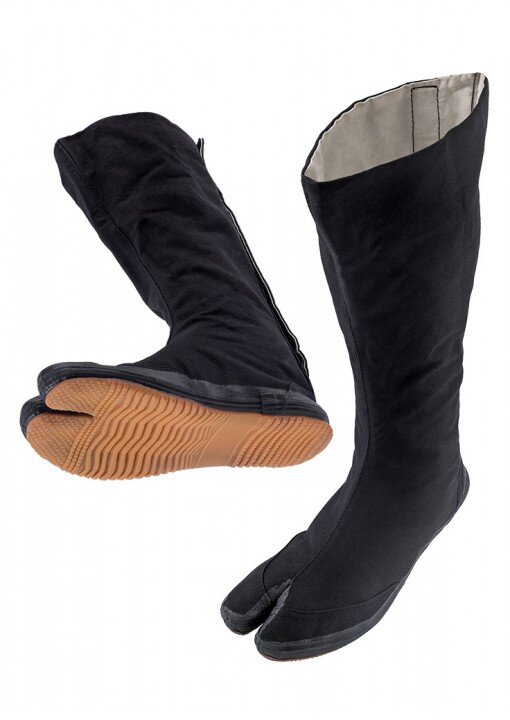
Image courtesy of dax-sports.com
Have you ever wondered why tabi, a.k.a. ninja shoes, have that separated toe? When you see them, I bet they make you think of ninja climbing walls and spying on important people to gain information.
Or, maybe you think about the Foot Clan in Teenage Mutant Ninja Turtles. Either way, these shoes are, and were, real.
And still used today.
Were Tabi shoes made for ninja, though? We’ll answer that later.
The rubber-soled Jika-Tabi is a real work shoe designed for construction, farmers, rickshaw drivers, and other manual laborers.
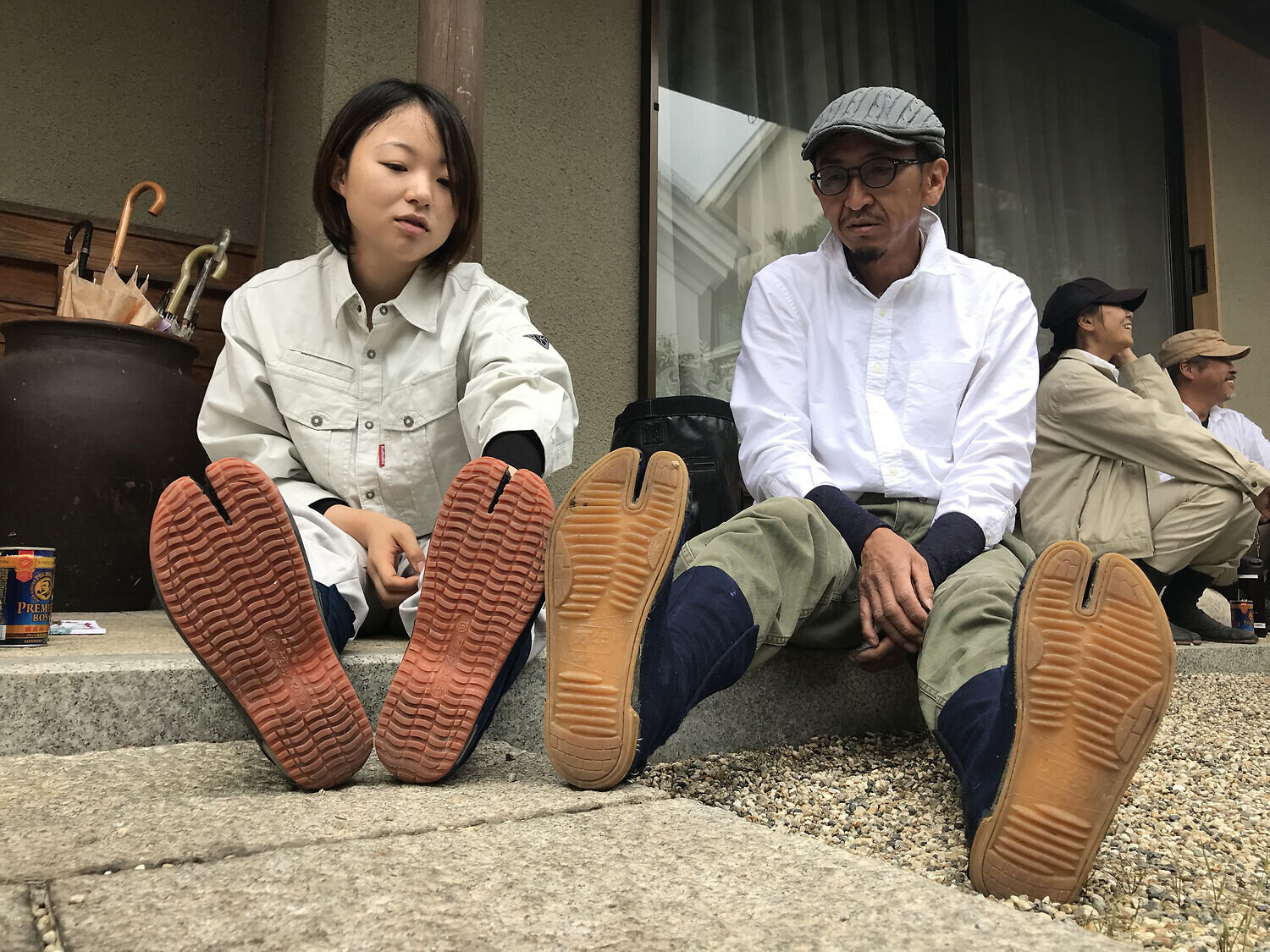
Gardening in Japan is perfect for Jika-Tabi shoes. Photo courtesy of niwaki.com.
When I lived in Osaka, I remember watching construction workers and being surprised by their split-toe Tabi boots. “Whoa.” I thought, “Even construction workers are ninja in Japan.”
I’ve enjoyed wearing Jika-Tabi before, and I’ll admit, something is soothing about having a toe separate from the others. The history behind the design was something I had to look into, though.
Why are tabi shoes designed in this way?
Back in the 15th century, Japan began importing cotton from their nearby neighbor, China. The new fabric gave birth to innovative products, like socks.
The Geta, a shoe that looks like a flat wooden platform sandal with a leather thong strap, was the footwear of choice, and new socks had to fit their structure. The result was creating an ankle-height cotton sock with a separation between the big toe and the rest of the foot.
Essentially, the original Tabi.

Photo courtesy of jpninfo.com.
Many years later, in the 20th-century, mass-produced rubber led to the birth of Jika-Tabi: Tabi that made contact with the ground like shoes. First introduced by Tokujirō Ishibashi, whose family owned a rubber business — his brother, Shōjirō founded Bridgestone tires — Ishibashi’s Jika-Tabi is closer to the version of the shoe we’re accustomed to seeing.
Different from its fashionable sock counterpart, the Jika-Tabi was a work shoe. In fact, the split toe was thought to aid in mobility during labor work and considered more agile than the solid closed shoe design.

Image found on Pinterest.com.
Wait a minute. What about Ninja? Well, there’s a common misconception that the tabi shoes were originally made for martial arts practitioners and that ninjas currently wear tabi shoes.
This image is false and was created when people watched kabuki theater. The actors backstage in kabuki would all be covered in black to blend with the stage and not be seen.
As you probably guessed, the actors all wore tabi shoes, and the black clothes implied them to be ninjas sneaking around in the shadows. Therefore, creating a false image and conception.
Of course, that expanded overseas, and Hollywood chose to add the famous split-toe footwear into ninja movies.
And, as they say, “the rest is history.”
If you’re working up high and need to stay steady while moving across scaffolding, I can see Jika-Tabi being a good shoe choice.
From my experience wearing them in Japan, you can easily feel the surface you’re standing on and better control your body.
This split-toe style has inspired the fashion world in the west with wild boots and shoe designs for men and women. Even Nike had a tabi running shoe a few years ago called Air Rift.

Nike Air Rift shoe image courtesy of ebay.com.uk.
If you’re interested in trying the Tabi shoe, I bet you can find plenty of different styles online. They’re pretty comfortable and will definitely make people give your feet a second look.
Struggling with creativity and putting your work out regularly? Join my email list and discover how to upgrade your mindset here.

With everything going on globally, we often feel like it’s our responsibility to comment or be prepared to share our individual viewpoints at the drop of a hat.
I don’t see it this way.
Your opinion is important, but if you haven’t researched a topic or formulated a personal take on the subject, there’s no need to feel guilty. In America, all you have to do is tell people, “I have no opinion on that matter yet.” Or respond with, “No comment.”
When I was living in Japan, people there would always say the phrase, “Shoganai ne.” which means “It can’t be helped.” Almost like giving in and saying, “What can you do?”
I loved the fact that people could just let go of their stress or worry by using that phrase, and it still feels like it matters to them.
Not like when people in the states comment with a “Meh.” or an “Oh, well.” Like they’re writing it off or flushing the topic down the toilet.
Saying shoganai feels like you care, but there’s not much you can do to make a change right now. You have to accept things the way they are for the time being.
Not being well-read on a topic or even caring about every aspect of everything isn’t possible. You have the right not to care. You have the right to be neutral.
How can we fully invest in every cause?
We’re all different and form opinions based on our backgrounds, experience, and knowledge of the subject matter. That’s a good thing. We don’t have to be all the same.
Trying to convince someone you’re right or get them to see your side isn’t necessary. You can agree to disagree.
Believe it or not, you may know quite a bit about a topic and still not be for or against it.
For example, for the Olympics in Tokyo, Japan, everyone’s talking about whether or not they should have waited another year after postponing it once before. With the pandemic still going strong and covid cases rising in Japan, it’s dangerous to bring a boatload of athletes into a small country to compete together.
On the other hand, Japan spent a huge amount of money preparing for the Olympics and would have lost big bucks if they canceled or kept postponing the games.
I lived in Japan for two years and want the best for the country, but it’s difficult for me to form an opinion on this situation. Both sides of the argument make sense. Is something wrong with me for not taking sides?
It looks like going ahead with the Olympic Games in Tokyo both helps and hurts Japan. This situation is not ideal by any means, but athletes have worked their butts off and deserve a chance to prove themselves in competition. I want them to have their chance, but I don’t want people to get sick and spread covid in a country I love.
What do you do if you can see both sides of the argument and neither of them wins out? You accept what is and throw up your hands with a look of confusion and say, “Shoganai ne.”
It can’t be helped. You’re in neutral and want the best, but what can you do?
Maybe you feel they should have canceled the Olympics until the pandemic improves across the world. I can see that side only because I care about the health of the people of Japan.
Having no opinion about anything shows you lack empathy. Pick your areas of interest and expertise and go ahead and comment on those all day. Friends and family will love knowing they can get your perspective on certain topics and look forward to conversations with you.
If you have zero opinions, no views about anything, you come across as aloof and bland. I’m sure there are areas where you get excited or upset by what’s going on. Topics that get your blood boiling are important. You don’t necessarily have to take only one side.
I’m not convinced people even care what we think. We’re all too concerned about ourselves and our opinions.
When you tell someone your side of the issue, they most likely will put it through their filters of what’s right and wrong to see if they agree. If they do, you look intelligent to them—like you’re on their team. If your ideas oppose theirs, you’re against them or are seen as wrong.
Either way, that person thinks they’re right. Rarely can we change how a person feels about a topic, right? Unless we have experience with it and tell a personal story to expand their view.
Let’s say you’re an expert in an area you work in or study daily. Great. Perhaps, that area is one where your opinion will be valued and paid attention to by others. If you’ve proved you’re worth in that subject, people could see you as a real spokesperson for that topic.
It doesn’t mean they’ll agree with you, though.
They might read more information about a subject to become better informed, but that doesn’t guarantee they’ll change their minds and believe the same as you.
Let that lift the weight off your shoulders. We’re not right about everything, and we cannot be experts on it all either.
If it’s a complicated situation, like the Tokyo Olympics, opinions can take time.
Putting thought, research, and care into deciding how you feel about something shows respect for the issue. If you’re not ready to share your opinion, you may have to stay in the neutral zone.
Sometimes we have to say “Shoganai ne.”
And that’s okay.

Image from CNN.com
Is a giant squid statue worth all the controversy it’s getting?
If you haven’t heard, in the coastal town of Noto, in Ishikawa, Japan, they spent $230,000 of the $6.2 million received from the government for Covid relief on a 43-foot sculpture of a flying squid. Could they have used their money on something more important — probably?
But I’m not mad.
In fact, I like that they spent some of their relief money on art. Mainly to promote tourism for their small fishing town. Apparently, the area is the center of squid fishing in Japan.
I never visited Noto while living in Japan. Still, now I’m interested in seeing the statue next time I can travel back to one of my favorite countries. Squid is a delicacy in Japan. Even though Americans might not be interested in eating it, it doesn’t mean the statue is a waste of money.
When it was unveiled, Japanese people were surprised by the timing, and so were people on Twitter. Guys, a ton of readers, most likely people who have never been to Japan, were upset about this giant flying squid.
According to this article by CNN news, someone commented, “No matter how you look at it, this is wrong. They have to return that money.”
Really? Is it that serious? Indeed, there are more important matters to get this upset about.
Here’s my take on why this isn’t such a huge deal.
In a town of around 16,000 residents, there have been fewer than 30 cases of Covid-19. Not that this is okay. It’s still a concern, but why can’t they take this opportunity to do something to put their area on the map?
I’m pretty sure that at the time this statue was approved and sculpted by the artist — most likely a year ago or so — Japan was doing pretty well controlling the virus. They probably thought it would be a positive way to celebrate victory over covid.
Unfortunately, cases have spiked in larger cities like Tokyo and Osaka, and hospitals have trouble keeping up with all the new patients. Scary times right now, for sure, and I’m hoping for the best. The Osaka area is my second home, and I want its citizens to stay healthy and the cases to drop.
Even though the statue’s unveiling timing is abysmal, I think they did what they thought was right when it was being created. Should we punish the town of Noto for that?
Even if Japan was doing well-handling covid, the virus was still causing huge dips in tourism. This town found an opportunity to provide funds to local artists and construction workers in this time of economic turmoil.
I bet this statue helped provide much-needed work while also investing in a new piece of fun, publicly accessible art — the perfect socially distanced tourist attraction.
Even I want to go and take a picture in front of it.
Art is essential and beautiful. Squid is delicious and well-loved by the people of Japan. If a family visits the town of Noto, you know the kids will laugh and smile while taking pictures. Parents and couples will share their squid photos all over social media.
This statue will bring not only tourists to the area but excitement and joy.
It’s easy for people outside of Japan to hear about this and think it’s ridiculous. Why? Is this an easy way to take a cheap shot at Japan? With all the controversy over the summer Olympics, should we cancel them or not, here’s another reason to be angry at Japan. I say, calm down and let a town beautify itself.
There are plenty of frustrating things about living in Japan and the experiences I went through. I didn’t fully understand why it’s that way. Still, I smiled, and whatever it was, let it go. As a Black man, having middle school students rub my skin to see if the brown would come off, for example, was one of those.
If I compare that to a small town deciding to use the money for a wild, eye-catching work of art to put their area on the map, I say go for it.
I’m confident Noto, Japan is not a corrupt town. If they needed the money to help save lives in their area, they would have used it for that purpose. Japanese people are pretty in tune with the needs of the many. Especially compared to other parts of the world where the culture revolves around thinking more about ourselves.
If I had any issue, it would be with the government giving so much money to an area with so few covid cases. They could have passed some of that on to bigger cities. Or, saved it for emergencies like the spike in cases happening right now.
With all the negativity, fear, and death in the world, let’s try and see the good in a tiny town trying to make the best of it all with the help of art.

Photo by note thanun on Unsplash
“If I move to another country, I’m staying myself. There’s no way I’m becoming a different person.”
A coworker said to me after telling him about my experiences living in Japan for two years, meeting my wife, and explaining how the experience changed me for the better. I shared that I had to become a different person while living there. The look of utter disbelief on his face threw me off.
He couldn’t see something like that happening to him. He explained further, “You never stop being who you are just because you’re in a different place. I’m always me at my core.”
I understood where he was coming from but disagreed and couldn’t think of what to say at the time in response. I knew for a fact this person never lived overseas. How could he know? I learned that he had visited other countries, sometimes for several weeks, but never spent a year or more in one. Let alone a country in Asia.
Living as an expat takes an open mind and a great deal of flexibility.
I believe, to respect the culture you’re living in, you have to change some of who you are if you hope to join in and succeed. Some of it means living the saying “When in Rome, do as the Romans do.”
The other side involves making peace with becoming a different person. You can’t stop it from happening. Accepting your change doesn’t make you weak.
If you’re a good person at heart, I think you can stay you deep down, but you will grow and evolve. I’ve seen how living abroad can change people for the worse and how they can even surprise themselves.
As soon as you leave a familiar environment and accept the fact that you’re not going back to it anytime soon, you change.
The jolt of culture shock hits right after arriving in Japan.
I moved to Osaka to teach English in Junior High Schools with the JET Programme. My interest in learning about the country, culture, and language brought me there. The application process for JET took almost a year, so I was thrilled when I was accepted and finally arrived.
JET chooses where to place you but gives you the option of living in the city, suburbs, or countryside. I’m not a big city person, so I chose the suburbs. Even though I knew very little Japanese, I figured there would be enough people who spoke English there to help me settle into life.
I was wrong.
Another JET teacher who lived in a town nearby was sent to my little area of Shimamoto, thirty minutes north of Osaka city by train, to help show me the basics. The apartment JET chose for me was old and unfurnished. I had to shop for futon mattresses, no western-style bed, that I would roll out every night to sleep right on the tatami mat floor. Totally different from how I slept in the U.S.
August, one of the hottest months in Japan, and my air conditioning unit was broken. I met the other JET teacher in town, and she told me I could buy a new one, but it might take a few days to get it delivered and installed. Of course, she, or someone who could speak Japanese, would need to come with me to buy one.
I remember crying alone that night thinking, “What have I done?” Traveled across the world from Atlanta, Georgia, to Osaka, Japan, without friends or family to live in an old hot, and humid apartment without air conditioning. The culture shock hit me hard.
Someone had to help me open a bank account, teach me how to get around on the subway. I worked in a school where I was the only non-Japanese person and couldn’t understand what anyone said.
Needless to say, I was uncomfortable. Living with discomfort was my everyday reality.
Did this change me? How could you say it wouldn’t?
I had experience with living abroad as a youth. My father worked as a diplomat, and I was fortunate to live in countries like Germany and the Bahamas during my middle school years. Moving to Germany was difficult because I didn’t speak the language. It was scary going out with family and not knowing what people were saying.
The way of life was similar enough to America I found. People were a little more reserved and private than in Georgia and took a long time to get to know you. Over time, I learned to understand the people and culture. I got the idea that the language barrier and having patience with settling in was the most challenging part about living in another country.
Traveling to live in Japan as an adult changed me even further. I was still me, but I discovered there can be much more to adjusting to a place when it’s very different than anywhere you’ve lived before.
I truly became a new version of myself.
If I had time to explain all of this to my coworker and condense it down clearly and concisely, I wonder if he would see my side?
Yes. You could be stubborn. Try and decide to behave like nothing in this new country can change you. I have a few ways this might prove difficult, however. Especially if you live in an Asian country where so much is so different.
The rules of polite society force you to change.
When you meet new people in Japan, you bow instead of shake hands. If you decide that just isn’t you and try to force a handshake, it will come off as odd or worse, rude. Not only do you bow, but you must learn not to bow too low depending on who you’re with. If you’re with a manager or an elder and you only give a little head nod, you’ll look like you’re being disrespectful.
Learning these specific cultural rules was exciting to me, but I didn’t catch on all that fast. I can’t even count the number of times I bent my head down low to bow for the principal at my school, and someone pulled me aside later to let me know, “Your bow. It was too low.”
Eventually, I learned but let me tell you, I still make mistakes today. Not growing up with this custom means it isn’t second nature and can be frustrating at times. Learning how to bow is a part of living in Japan; you must learn.
You are seen as a foreigner and not a citizen.
As an expat in Japan, you’re seen as a minority, even though you might have been part of the majority in your home country. Several white friends of mine had a real hard time with this realization. They stood out everywhere and weren’t used to it.
They were seen as exotic and strange yet cool and interesting but not looked at as equals. Not as Japanese. If you don’t look Asian, you will be seen as a foreigner immediately—you can’t blend in. Even if you’ve lived in Japan for thirty years.
You start to see yourself differently. Wondering what you can do to fit in. Learning to speak Japanese to communicate better or working for a Japanese company might help. Perhaps, but on the outside, you’ll still look foreign—different.
What might this do to you over a long period of time? Thinking it won’t mold you into a different person isn’t realistic.
Getting away with more than in your home country.
Looking different and being a foreigner in Japan has its advantages as well. You can get away with not following some of the rules of society in ways Japanese people can’t. No one will expect you to be an expert with all the rules of Japanese society.
Some Japanese friends you make may feel envious of how much more relaxed your life can be in Japan compared to theirs.
When my wife and I were visiting Tokyo several years ago, we had our suitcase with us after checking out of our hotel but wanted to do more sightseeing. A major hotel chain in the area we wanted to explore had a line of people, staying at the hotel, no doubt, giving their bags over to be held until they checked in. I had the idea to act like we were staying there and ask them to hold our suitcase until we come back in a few hours.
My Japanese wife, thought it wouldn’t work, especially if she’s with me. As a tall Black man from America, I could probably get away with it by myself, though. I had to try.
Sure enough, I got in line, fully expecting someone to ask me which room I’m staying in or to show proof I checked in at the hotel, but no. They just smiled, took my bag, and gave me a return ticket—as my wife watched in amazement at a distance.
This is called a “Gaijin Smash” by some expats. When you take advantage of a situation, most Japanese citizens can’t because you know you won’t get in trouble. The word “gaijin” is slang for foreigners. This fact makes overseas travelers say and do things they never would at home, somewhat like foreigner privilege.
There’s no way I would have tried something like this in America. I felt a bit guilty for flexing my foreign powers, but we were able to enjoy the rest of the day without lugging our suitcase around. When I came to pick my bag up, they happily returned it free of charge with no questions asked.
The fact that this is possible changes you. You rationalize and try to make it okay by thinking of all your frustrations with living in the country. Reviewing in your head the times you didn’t fit in, made mistakes, and embarrassed yourself. The studying like crazy to learn the language and never speaking quite fluently enough. “I deserve some breaks every now and then.” you think.
Living in Japan is hard. Making a life for yourself is challenging anywhere, let alone in a foreign country.
The expat exceptionalism can consume you. Unless you paid attention to how you’ve changed and decided what stays and what goes, it could turn you into a monster. Recognizing the privilege that comes with being different in Japan means thinking deeply about your actions and who you are.
I don’t think I did as much of that before Japan.
Allowing people who are different from us to open our minds.
Learning to live in another culture can help you appreciate differences and see people for who they are as humans. Because of this, you’re forced to look in the mirror at yourself and your beliefs. In fact, that can be the most challenging part of travel.
My coworker may feel like living abroad could never change him, but it’s inevitable. You will change.
If you live in Europe, maybe not as much. Surely, you will need to adjust to different cultural expectations there, too, and different attitudes towards world politics, religion, and relationships. You will still grow and change.
If we can see that as a good side effect to travel and accept rather than reject how we’ve adapted to new environments, our tolerance for differences will grow. I hope more people will spend time in other countries and take on the personal growth involved in living abroad.
You can read Khalid Birdsong’s comic strip inspired by his experiences living in Japan at www.friedchickenandsushi.com
Sometimes you need to sleep. I’m talking about amongst the people, on a train or bus, or even in the park. Life can be exhausting. Why can’t we do some of our recharging in public?
Well, now you can, with this simple three-step method inspired by my years living in Japan. The word “inemuri” means being present while you sleep. It’s synonymous with sleeping on the job or in public places. The Japanese are so overworked that it’s become commonplace to see a large number of people sleeping just about anywhere.
Taking naps is said to be a good thing. Even though accepted in Japan, it’s not allowed at work—even though that rule is mostly ignored all the time. If you’re in a location where you can set an alarm to wake you, it’s relatively easy, but what if you’re on a train or the subway? Not waking up in time for your stop can be frightening.
Listen in as our Japanese raccoon, Tanuki, from Fried Chicken and Sushi comics explores how to nap on the subway in three steps.
Decide to give it a try with the intent to master inemuri with help from others.

2. Pick a friend or family member who you know would never let their guard down.

3. Ride on a train with a loudspeaker that penetrates your soul.

Great job! If you follow these Tanuki steps, you too will be sleeping on the train in no time. Just imagine the freedom you’ll have to get the rest you need anywhere you have to wait.
Take these tips to the cafe, while waiting for your coffee, or to the DMV, waiting for your number to be called. There are so many uses, and you’ll feel well-rested and ready to tackle whatever life throws at you daily.
Now, get out there and nap.

Drawing Little Fried Chicken and Sushi comics on paper, during these crazy times, has been good for my soul. There’s so much magic in feeling the paper’s pull and having to be fully present with every line drawn in ink. Not to mention, I can take cool photos of my originals and share them with you.
Don’t worry. I’ll still make strips digitally as well. From here on out, I think the story will dictate whether or not I use Clip Studio Paint software or bristol board and Pigma Micron pens.
The Black Samurai is back! This time, he’s mixed with the true story of the real African Samurai, Yasuke.
Read MoreAs soon as you can.

Taking a break from the U.S. is not an option right now due to COVID-19, but I wish I could travel overseas. No country wants us to visit or move there during this pandemic, and I understand why. We look like crazy people.
The freedom we think we have gives us the confidence we feel we need to only care about ourselves — like it’s the natural way of things. Friends of mine in other countries are scared of Americans. The ridiculous mess we’ve made over here in regards to racism and the pandemic looks insane.
How we treat anyone who’s slightly different–yelling at an Asian person wearing a mask because you think they have COVID and then going out for FroYo without wearing a mask yourself because you feel it takes away your freedom.
I remember enjoying my break from America while living in Osaka, Japan, and teaching English. It’s certainly not an easy country to live in as a foreigner, but at least I didn’t fear for my life. You’d be amazed at how your country looks from the outside looking in. Yes, you miss some of what you love, but racism in America sticks out like a hamburger at a sushi restaurant. Be careful; you think it might taste good, but you know it’s wrong and shouldn’t be there.
I hear people saying things like leaving America shows weakness, and you should stay and make it work. Isn’t that like staying in an abusive relationship with someone because you think you can help them change? If you have a way out that can work for you and your family, take it.
Black people should do everything they can to experience living in another country, preferably one where people of color are in the majority. Move to Asia, Africa, or South America. Get a sense of what it’s like outside of white American ideals and perceptions.
Where will you travel when everything opens up again? Start planning, saving, researching now. I know it may seem impossible or out of reach, but it’s not. Take the first step by deciding you are a person who can travel and make a change.
Do it. Go on an adventure that changes your life and opens your mind. Then never look back.

Imagine watching nine massive steamships for the very first time in your life, something you never knew existed, approaching Edo bay near modern-day Tokyo in February of 1854. Commodore Matthew C. Perry landed his ships in Japan, uninvited mind you, in an effort to force diplomatic relations with the Shogun and open trade.
After over two hundred years of isolating itself from the rest of the world, Japan and the average Japanese citizen knew nothing of other countries or races. Witnessing white soldiers march off their metal ships and make the demand “Take me to your leader.” must have felt close to aliens from outer space landing on our planet.
The scare tactic worked. There was no way Japanese forces could have stood a chance against the might of the U.S. military at that time. On March 31, The Treaty of Kanagawa was signed between America and Japan. The country was open to the world. Even though it would take many years to establish international trade, Japanese people were thrust into accepting a new truth. They were not alone in the universe.
What limiting beliefs are you holding on to with little knowledge or experience to back them? The world is forcing us all to open our minds. Experiencing the pandemic and watching racial injustice and protests are making us realize we’re all human. Making us see that caring about the health and well being of people is what really matters.
The truths of our modern world have landed. Open your heart.
While going through a pandemic and Black Lives Matter protests worldwide like Hachiro in the above FC&S comic strip, we’re all waiting for the next big event that will turn the world upside down. Could it be an alien invasion? Or, perhaps, off-world beings deciding we’ve gone too far and then making themselves known to us somehow to calm us the heck down?
We should all be prepared for more fantastic events that bring us together as a human race.
Read More
I was afraid to post this comic strip, but I knew it had to be said. America is a dangerous and downright scary place for Black people. Even though no area you live in is perfect, there are some countries and even cities where you can feel more like yourself.
I found Osaka, Japan, to be one of those places for me. If you travel enough, you’ll find yours. Is it acceptable, however, for me to talk about racism in a cute family comic strip intended to make you laugh?
I lived in Japan for two years teaching English, but now I live in the U.S. and visit Japan every year. Making a point to soak up the peace and experience the culture. Don’t get me wrong, there are aspects I love about my home country.
Let’s be real, though, it’s tough on black folks in the states. The fear of racism and police brutality makes everyday life feel scary when you’re doing just about anything.
I think it’s important to address racism and perception in comic form and get people thinking. Even if the humor just makes you uncomfortable. As a Black man, my work wouldn’t feel authentic without it. The character, J, in this strip, is communicating how I feel while living in or visiting Japan as a Black man.
Free to be me.
Even though it’s told from a child’s point of view in this strip, the sentiment comes from my raw emotions and frustrations. But I was nervous about posting it and almost didn’t. You want to know why?
I was concerned about hurting white people’s feelings.
The comics and articles I create are not made to upset anyone but give my perspective, as a Black man, on the world and how I see things. In the past, after posting a series of lighthearted comics and then suddenly putting a strip out stating America isn’t a perfect union, mainly white people get upset.
It’s like they can’t handle the truth. Could it be certain white folks think I don’t have a right to express my frustrations and concerns over how people of color are treated in America? Like I can’t talk about my people and our struggles through an art form I love. Maybe, I should just stick to the silly jokes.
I know, free speech works both ways. If I can say what I feel in my work, people should have the freedom to comment on it. Yes, but when you do, please pay attention to your privilege.
Are you trying to tell me I’m wrong for how I feel? If you think my comics are now “complete garbage” from one comic strip and you can’t read them anymore. Why? Are there deeply held beliefs that need changing, lurking deep inside you? When you read through my archives, plenty of previous Fried Chicken and Sushi comics tackled racism and prejudice concerning people who are different.
White people get to choose what they believe about racism even though they haven’t experienced it directly. Being a part of the majority, they get to say ridiculous things in the comments of my comics. Like, “This is racist.” or an insult dressed up as a compliment, “I don’t see color” (please see my color, I happen to love it) or “Racism doesn’t exist in America anymore.” Does anyone really believe that?
Black people have to live with and take the blows associated with racism daily. Just because you aren’t seeing racist acts in your neighborhood or workplace, doesn’t mean they don’t exist.
I like showing that we all have other choices of places to live in the world. The truth is, it ain’t easy traveling abroad either. Finding work that pays enough to live on, and securing a way to stay there for many years — like getting your visa sponsored by an employer or becoming a permanent resident. But it is possible if you want it bad enough.
Notably, in Asia. You will deal with prejudice and ignorance about your race, especially if you’re Black. Still, the lack of fear and hate over your skin color brought on by systemic racism makes up for it.
The freedom that comes from living in a country like Japan — not built on the backs of free labor from African slaves — feels exhilarating. People see you as a person, a very different person than them for sure, but not someone to fear as a threat to their livelihood.
I know all of this and feel strongly about the benefits of living in Asia. I’m choosing, however, to work in the U.S. right now. I find it easier to get work that pays well, and I like engaging with a diverse group of people. When I need a break, the money I put away for travel helps me escape to Japan, the Philippines, or Hong Kong to get a different experience.
Where I can be just a foreigner.
Returning to my home country from trips abroad can be a tough re-entry. I get hit with the reality that most American citizens still do not fully see or understand. You hear the words “Black Lives Matter” but Black people are still treated poorly. This “BLM” phrase doesn’t mean all other lives have it easy. It means Black lives, particularly in America, need to matter now more than ever. Our house is the one on fire in the neighborhood. It’s the one that needs the most attention right now. Let the fire department put out the flames. Should they spray all the other homes on the street with water, just to be fair?
I think things are getting better. The above FC&S comic received mostly supportive comments and started conversations on GoComics around the benefits of travel and having an open mind.
It was a risk I was glad I took. Please become comfortable listening to what Black people are saying about their experiences, hopes, and challenges when expressed through their writing and creative work.
Give us a chance to matter.

Photo by Galen Crout on Unsplash
Moving back home to the U.S. after living in Japan for two years was a shock to my system in more ways than one.
You always hear about how harmonious and helpful everyone is in Japan. I love the country, but it’s not an easy place to live as an ex-pat, especially if you speak very little Japanese.

Photo by Alexander Smagin on Unsplash
Life in the ‘land of the rising sun’ does have its perks, though. You can have a level of peace and solitude that I find difficult to come by in the United States. Crime is low and everyone is accustomed to living politely (and quietly) with their neighbors.
That tranquility among the noise is a massive part of what I miss about being in Japan.
I felt like a human being instead of a threat.
Living in Japan for two years as an African-American male was a challenge, but also liberating.
I was an English teacher with the JET Programme and truly loved the cultural exchange with the students and teachers in the Junior High Schools where I worked.
For me, in particular, I was not just a “black man” there, with all the fear and stereotypes that come along with it. I found I was lumped into one general category—foreigner.
Students saw me as a person from another country, fascinated with my hair and curious about what America was really like.
As I walked the streets of Osaka, I felt like a person and not someone the public would see as a threat. It was miraculous!
Sometimes people stared because I looked different.
Only because I wasn’t Japanese and not because I was black. Being six feet three, I found people were also mesmerized by my height.
It was astounding, no women clutched their purses as they passed or crossed the street when they saw me walking towards them on the sidewalk.
The biggest load-off my mind? Not worrying about getting shot by the police. I’m dead serious. That was a game-changer.
You should always be aware of your surroundings anywhere you go. Still, I’ll admit, I became pretty relaxed within the safety of the cities in Japan. Watching my back became a distant memory.
I felt like a person.
I love my country but after years of feeling like the “negative other” in America, I can forget I have value. Believe it or not, when I’m in the U.S., there are plenty of instances when I feel like saying the phrase popularized by Jesse Jackson, “I am somebody” to myself. Just to remember, I matter.
I have to consciously think about this when moving through life in the U.S. Tell myself I have value. Most of the negative stereotypes for black people perpetuated in the media and entertainment, tell a different story.
When I daydream about moving to a quiet rural area, where I can have solitude, reality always seeps in. It’s not the answer for all people. Jobs may be scarce, and if you’re not independently wealthy, you’ll need to pursue a career in a major city to make money to live the life you want.
Even as a black male, I’m afraid people living outside of big cities may have fewer interactions with people of color and be more closed-minded.
Living in Japan, experiencing each day as a different kind of “other”— compared to in America— was a special time in my life. I will say though, I do know through that experience, what it feels like to be seen as scary, only because I look different.

Photo by Laura Thonne on Unsplash
You experience prejudice as a foreigner in Japan. It’s just different.
Each day wasn’t perfect. There were times I would sit down on a subway train, and the person next to me would stand up and walk to a different area. Renting an apartment can be a challenge because some buildings do not rent to non-Japanese.
Getting together with other ex-pats helped relieve some of the microaggressions. You quickly understand that it doesn’t matter where you’re from or the color of your skin. If you do not look Japanese, you have situations where you are treated as a guest and not a citizen. Everyone could relate, come together, and vent their frustrations and also share what they love about living in Japan.
I often thought about how sad it was I had to leave my country of birth and move all the way to Asia to feel safe and at peace.
You don’t need to live in Japan to find yourself. Although, for an experience of a lifetime, visiting is most certainly recommended. The country is beautiful, rich in history and culture, and Japanese people are very kind to visitors. Things get more complicated when you live there for a long period of time.
Don’t let this scare you.
Have the courage to move to a new place if you feel the urge to experience something exciting and different.
I’m still searching for my next tranquil place to call home. Something close to what I had in Japan. The reality of moving to any new country will always stick with me, though.
Living abroad helps you understand that no country, city, or neighborhood, is perfect.
When I find my next tranquil home, I expect to enjoy the positives and take the negatives with a grain of firm salt.
Fried Chicken and Sushi is a Blog and humorous comic strip about living in Japan and Japanese pop-culture.
© copyright 2010 - Khalid Birdsong All Rights Reserved.